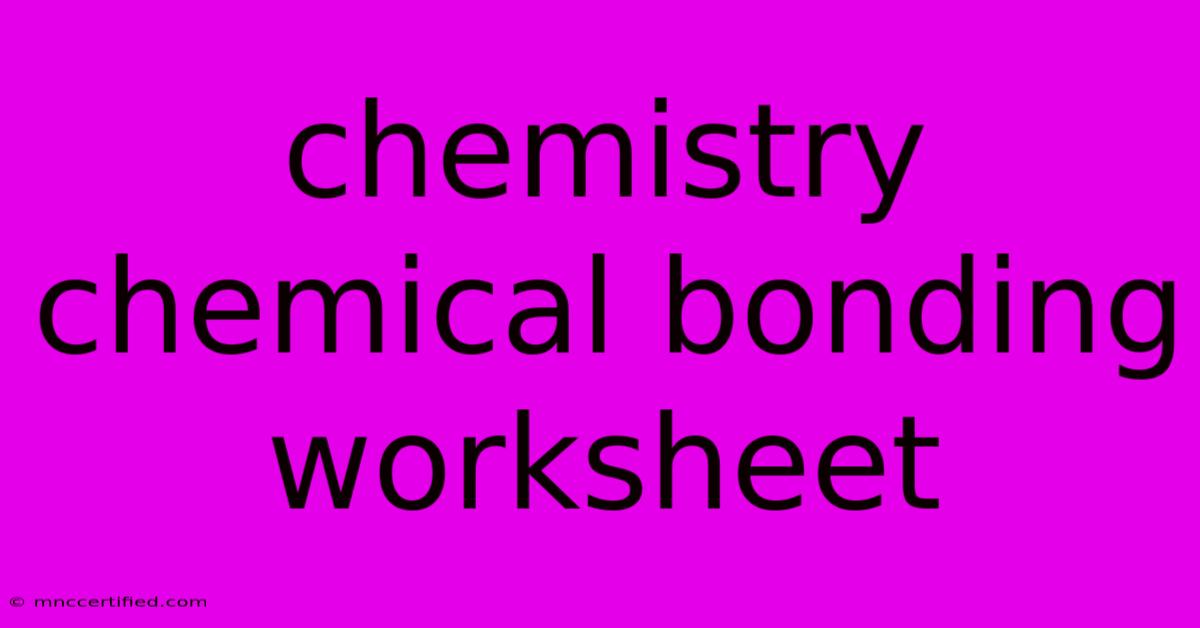Chemistry Chemical Bonding Worksheet

Table of Contents
Mastering Chemical Bonding: A Comprehensive Worksheet Guide
Chemical bonding is a fundamental concept in chemistry that explains how atoms interact to form molecules and compounds. Understanding chemical bonding is crucial for comprehending the properties and reactions of matter. This article will guide you through a comprehensive worksheet designed to solidify your understanding of chemical bonding.
Worksheet Structure and Key Concepts
The worksheet will cover essential aspects of chemical bonding, including:
- Types of Bonds: Explore the differences between ionic, covalent, and metallic bonds. Learn how to identify the type of bond based on the participating elements and their electronegativity.
- Lewis Structures: Draw Lewis structures for various molecules and polyatomic ions. This will involve identifying valence electrons, applying the octet rule, and understanding lone pairs and bonding pairs.
- VSEPR Theory: Apply the VSEPR (Valence Shell Electron Pair Repulsion) theory to predict the molecular geometry of molecules. Determine bond angles and understand how electron pairs influence molecular shape.
- Polarity and Intermolecular Forces: Analyze the polarity of molecules based on bond polarity and molecular geometry. Explore different types of intermolecular forces like hydrogen bonding, dipole-dipole interactions, and London dispersion forces.
- Hybridization: Understand the concept of hybridization, where atomic orbitals combine to form hybrid orbitals. Identify the types of hybridization (sp, sp², sp³) and their relationship to molecular geometry.
Worksheet Activities and Examples
Activity 1: Bonding Types and Properties
- Objective: Identify the type of bond present in various compounds and explain the properties that arise from that bond.
- Examples:
- NaCl: Identify the bond type as ionic and describe its high melting point and electrical conductivity in the molten state.
- CO₂: Identify the bond type as covalent and explain its low melting point and lack of electrical conductivity.
- Cu: Identify the bond type as metallic and explain its malleability, ductility, and high electrical conductivity.
Activity 2: Drawing Lewis Structures
- Objective: Draw Lewis structures for various molecules and polyatomic ions, applying the octet rule and understanding lone pairs and bonding pairs.
- Examples:
- H₂O: Draw the Lewis structure, showing the two lone pairs on the oxygen atom.
- NH₃: Draw the Lewis structure, showing the lone pair on the nitrogen atom.
- CO₃²⁻: Draw the Lewis structure, considering the resonance structures.
Activity 3: Predicting Molecular Geometry
- Objective: Apply VSEPR theory to predict the molecular geometry of molecules and determine bond angles.
- Examples:
- CH₄: Predict the tetrahedral geometry and 109.5° bond angles.
- H₂O: Predict the bent geometry and approximately 104.5° bond angles.
- CO₂: Predict the linear geometry and 180° bond angles.
Activity 4: Analyzing Polarity and Intermolecular Forces
- Objective: Determine the polarity of molecules based on bond polarity and molecular geometry. Identify the dominant intermolecular forces present in different compounds.
- Examples:
- H₂O: Analyze its polar nature due to the bent geometry and the presence of hydrogen bonding.
- CO₂: Analyze its nonpolar nature despite having polar bonds due to its linear geometry.
- CH₄: Analyze its nonpolar nature due to its tetrahedral geometry and the absence of significant electronegativity differences.
Activity 5: Exploring Hybridization
- Objective: Identify the type of hybridization (sp, sp², sp³) in different molecules and its relationship to their geometry.
- Examples:
- CH₄: Identify the sp³ hybridization and its contribution to the tetrahedral geometry.
- CO₂: Identify the sp hybridization and its contribution to the linear geometry.
- H₂O: Identify the sp³ hybridization and its contribution to the bent geometry.
Tips for Success
- Review Basic Concepts: Ensure you have a strong understanding of atomic structure, electronegativity, and the octet rule before tackling the worksheet.
- Practice Regularly: Work through the worksheet examples and complete additional practice problems to reinforce your understanding.
- Seek Help: If you encounter difficulties, don't hesitate to ask your teacher or a classmate for assistance.
By diligently working through this chemical bonding worksheet, you will develop a solid foundation in this crucial area of chemistry. Remember, understanding chemical bonding is the key to unraveling the complexities of matter and its interactions.

Thank you for visiting our website wich cover about Chemistry Chemical Bonding Worksheet. We hope the information provided has been useful to you. Feel free to contact us if you have any questions or need further assistance. See you next time and dont miss to bookmark.
Featured Posts
-
Cardinals Ground Game Powers First Place Win
Nov 11, 2024
-
Chelsea Triumphs At Liverpool Building Momentum
Nov 11, 2024
-
Barcelona Upset Sociedad Claims Victory
Nov 11, 2024
-
Roof Inspection Report For Insurance
Nov 11, 2024
-
Cost Of D And O Insurance For Nonprofits
Nov 11, 2024